Ben Van Berkel is a Dutch architect, founder and principal architect of the architectural practice UNStudio, which is a Dutch architectural firm specializing in urban infrastructure projects. With his studio he designed, among others, the Erasmus Bridge in Rotterdam.
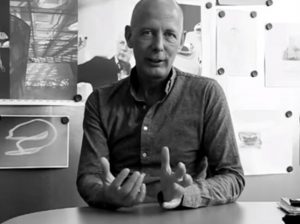
Image source: https://en.wikipedia.org/wiki/Ben_van_Berkel#/media/File:Ben_van_Berkel_portret,_2017.jpg
Who Is The Dutch Architect?
Ben van Berkel was born in 1957 in Utrecht, Netherlands. He studied architecture at the Rietveld Academy in Amsterdam and at the Architectural Association in London, receiving the AA Diploma with Honours in 1987. In 1988, together with his wife Caroline Bos, he set up an architectural practice in Amsterdam named Van Berkel & Bos Architectuurbureau, which realized, amongst others projects, the Karbouw office building, the Erasmus Bridge in Rotterdam. In 1998, van Berkel and Bos relaunched their practice as UNStudio, where UN stands for “United Net”. With his studio, he designed the Erasmus Bridge in Rotterdam, the Moebius House in the Netherlands, the Mercedes-Benz Museum in Stuttgart, Germany, Arnhem Central Station, the Singapore University of Architecture and Design, Raffles City in Hangzhou and numerous other buildings.
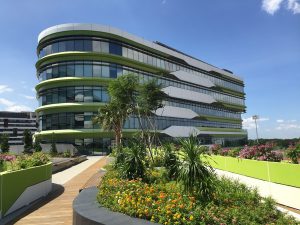
Image source: https://commons.wikimedia.org/wiki/File:Singapore_University_of_Technology_and_Design_-_20150602-06.jpg
Ben van Berkel has lectured and taught at many architectural schools around the world. He has led Diploma Units at the Berlage Institute in Rotterdam (1992-1993) and the Architectural Association in London (1999). Before his role as Professor Conceptual Design at the Städelschule in Frankfurt (2001-2016), he was Visiting Professor at Columbia University, Princeton University and Harvard University. Ben van Berkel has received many personal awards and affiliations, such as the Eileen Gray Award (1983); the British Council Fellowship (1986); the Charlotte Köhler Award (1991); Member of Honor of the Bund Deutscher Architekten (1997); the 1822-Kunstpreis 2003 (Mercedes-Benz Museum, Stuttgart) (2003); the Charles Jencks Award (2007); the Honorary Fellowship AIA (2013); and the Kubus Award (2016). Currently, he is Professor Conceptual Design at the Staedelschule in Frankfurt am Main and was recently awarded the Kenzo Tange Visiting Professor’s Chair at Harvard University Graduate School of Design.
Info source: https://www.revolvy.com/page/Ben-van-Berkel
What About Van Berkel’s Most Popular Works?
- Erasmus Bridge in Rotterdam, Netherlands
The Erasmus Bridge in Rotterdam was completed by Van Berkel in 1996, before he and his wife Caroline Bos changed the name of their office from Berkel and Bos to the best known UNStudio. The bridge is 800 meters long and crosses the river Meuse, connecting Rotterdam south with the city center. It is characterized by a white pylon of 139 meters high which is a prominent shape on the city skyline, thanks to its unusual shape. Rather than consisting of a simple vertical, its base runs parallel to the surface of the ground, then bends a corner before bending forward. A particularity of this bridge is its silhouette that has been compared to that of a swan. UNStudio describes it as “a sky-colored steel cantilever that can look as thin as a needle or as wide as a harp“.
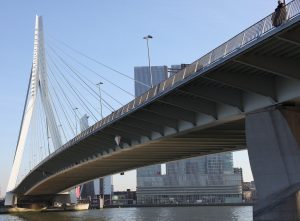
Image source: https://search.creativecommons.org/photos/cd3b6163-087f-493d-a899-717031095f7f by rick ligthelm
The bridge has four bays, of which the longest measures 280 meters. They create two pedestrian paths, two cycle paths, tram tracks and two lanes for road traffic. Thirty-two stuck to the top of the pylon take most of the weight, supported by eight backstairs and five concrete pylons. The southernmost span, on the other hand, has a 89 meter long action frame, a section that bends to allow the passage of large ships. In 2016, the Erasmus Bridge celebrated its 20th anniversary. Since its construction, the surrounding area has been populated by a series of buildings by well-known architects, from Renzo Piano’s KPN Tower (2000) and from Mecanoo’s Montevideo Tower (2005), to Alvaro Siza’s New Orleans (2010) and OMA’s De Rotterdam (2013).
Info source: https://www.dezeen.com/2015/12/05/a-z-advent-calendar-erasmus-bridge-ben-van-berkel-unstudio-rotterdam/
- Ponte Parodi in Genoa, Italy
On May 15, 2001, UN Studio, made up of young Dutch architects Ben van Berkel and Caroline Bos, won the “Ponte Parodi and the city of Genoa”, a prestigious international competition in Genoa. The auctioneer body, the Old Port of Genoa, with a budget of 340 billion lire, has announced the competition for the redevelopment of 23,000 square meters on the seafront of a former industrial area, Ponte Parodi. Using the strategic position of the pier, Ponte Parodi, in the Porto Antico system, the competition aims to give a renewed image of Genoa as a world-wide tourist destination and, responding to the strong increase in presences in the port area, foresees the realization of infrastructure and parking. The UN Studio project consists of a huge square, with an interesting topography, that covers a complex of parking lots and multi-purpose spaces. The shape of the square, three-dimensionally modulated, allows the largest area of use possible to meet the demand for parking and square.
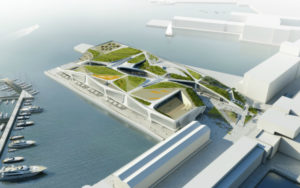
Image source: https://www.unstudio.com/en/page/3294/ponte-parodi
At the lower level, the pier is divided into square units to allow efficient parking organization. To facilitate pedestrian circulation, the grid is broken up progressively moving the individual units apart. A floating pier joins Ponte Parodi to the Magazzini Generali, creating a link between the various attractions on the other piers. There are facilities for docking cruise ships. It is a huge public space built on a container with infinite possibilities of use that, as the authors say, “each one distributes possible functions on the pier in relation to the urban, tourist and university context, and suggests a series of activities depending on the period of day and year and visual cuts“. The structure is made of steel and glass. The project creates for Genoa a large square open on the Mediterranean ready to welcome thousands of people from the city and the sea.
Info source: http://www.archimagazine.com/aunstud.htm
How Can We Distinguish The Main Characteristics Of His Style?
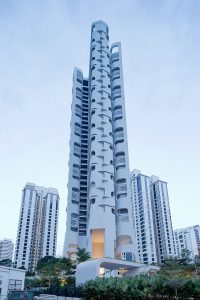
36, Singapore ,2013
Image source: https://en.wikipedia.org/wiki/Ardmore_Residence
Ben van Berkel succeeds in transforming architecture to sculpture. His design is innovative. His artistic language makes use of the possibilities of computer-aided animation. His designs are eye-catching but at the same time respect historical structures as illustrated by the Erasmus bridge in Rotterdam, the new Mercedes- Benz Museum in Stuttgart and the urban concept for Genoa harbour. Central to his teaching is the inclusive approach of architectural works integrating virtual and material organization and engineering constructions. According to Architect Ben van Berkel, “Our ideas and solutions differ to a large extent in each our projects. Fundamental to our practice is the idea that new concepts for architecture can be generated almost everyday. We at UNStudio strive to create fully contemporary works and to be fully absorbed in the process. And for this, we have many experts from a wide variety of fields involved in our projects as we call our practice a United Network.“
Info source: http://www.bestinteriordesigners.eu/top-architects-ben-van-berkel/
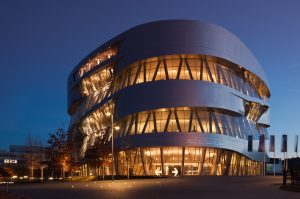
Image source: https://en.wikipedia.org/wiki/Mercedes-Benz_Museum#/media/File:Mercedes-Benz_Museum_201312_08_blue_hour.jpg
